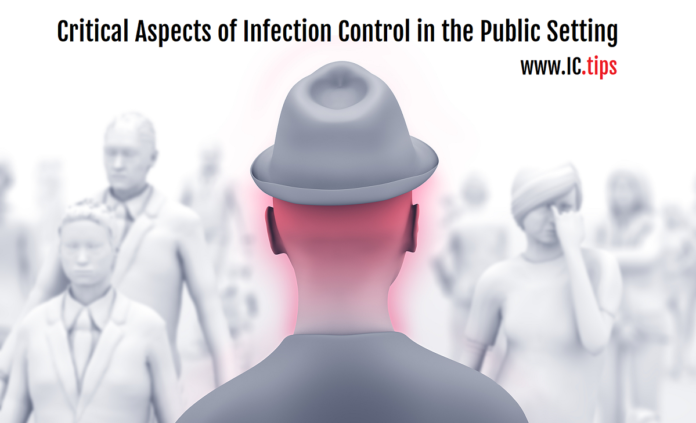Infection control refers to evidence-based measures and practices that are put in place to prevent the spread of infectious diseases within a community or public setting (1). This is particularly important in public places where individuals from different backgrounds and health conditions encounter one another. By controlling the spread of infections, we can minimize the risk of outbreaks and protect the health of individuals, communities, and society (2).
Below are five effective control measures that we all should consider and work towards:
- One of the key aspects of infection control, and not limited to the public setting alone, is the implementation of proper hand hygiene practices. This involves washing hands regularly with soap and water or using hand sanitizers to kill germs that may have accumulated on the skin. In addition, hand hygiene should be carried out after using the bathroom, sneezing or coughing, before eating, and after handling potentially contaminated objects or surfaces (1).
- Another important aspect of infection control is the implementation of proper respiratory etiquette. It involves covering the mouth and nose when coughing or sneezing and disposing of used tissues properly. It is also important to avoid close contact with others when displaying symptoms of an infection and to wear a mask in crowded public spaces where it is difficult to maintain physical distancing (3, 4).
- Maintaining a clean and hygienic environment is crucial for infection control in public settings. Best done by regular cleaning and disinfection of high-touch surfaces such as door handles, elevator buttons, and public restrooms, as well as ensuring proper ventilation and air circulation. Cleanliness should also be maintained in food preparation areas, such as restaurants and cafes, to reduce the risk of foodborne illnesses (5, 6).
- In addition, infection control in public settings also requires implementing physical distancing measures. Maintaining a safe distance between individuals to reduce the risk of droplet transmission is essential. Physical distancing measures are crucial in crowded public places (if possible), such as shopping centers, markets, and public transportation, where individuals are more likely to come into close contact with one another (7).
- Public health authorities have a mission-critical function by promptly monitoring and responding to infectious disease outbreaks. Therefore, speed is of the essence. This involves carrying out surveillance, case finding, contact tracing, and providing information to the public on how to prevent the spread of infections (8, 9).
As demonstrated in the latest epidemic, infection control in the public setting is crucial for protecting the health of individuals and communities. Effective infection control measures involve proper hand hygiene, respiratory etiquette, maintenance of a clean and hygienic environment, physical distancing, and timely monitoring and response to outbreaks. By implementing these and other additional measures, we all can minimize the risk of infectious disease outbreaks and protect the health of individuals, communities, and society.
References
1. CDC (2022). Handwashing in Communities: Clean Hand Saves Lives. Retrieved February, 2023, from https://www.cdc.gov/handwashing/index.html
2. OHSAS (2023). Good Hygiene Practices – Reducing the Spread of Infections and Viruses. Retrieved February, 2023, from https://www.ccohs.ca/oshanswers/diseases/good_hygiene.html
3. CDC (2016). Respiratory Hygiene/Cough Etiquette. Retrieved February, 2023, from https://www.cdc.gov/oralhealth/infectioncontrol/faqs/respiratory-hygiene.html
4. CDC (2022). Use and Care of Masks. Retrieved February, 2023, from https://www.cdc.gov/coronavirus/2019-ncov/prevent-getting-sick/about-face-coverings.html
5. IMS (2022). Ways to maintain a Hygienic Work Environment. Retrieved February, 2023, from https://theimsco.com/ways-maintain-hygienic-workplace-environment/
6. Keystone (2017). Infection Prevention for Full-Service Restaurants. Retrieved February, 2023, from https://www.cleanwithkeystone.com/news-and-insights/05622-infection-prevention
7. WHO (2022). COVID-19: Physical distancing. Retrieved February, 2023, from https://www.who.int/westernpacific/emergencies/covid-19/information/physical-distancing
8. Ellwanger J.H, et al (2021). Control and prevention of infectious diseases from a One Health perspective. Genet Mol Biol. 2021; 44(1 Suppl 1): e20200256. Retrieved February, 2023, from https://www.ncbi.nlm.nih.gov/pmc/articles/PMC7856630/
9. Minnesota Department of Health (2022). Government’s responsibility for public health. Retrieved February, 2023, from https://www.health.state.mn.us/communities/practice/resources/chsadmin/mnsystem-responsibility.html












